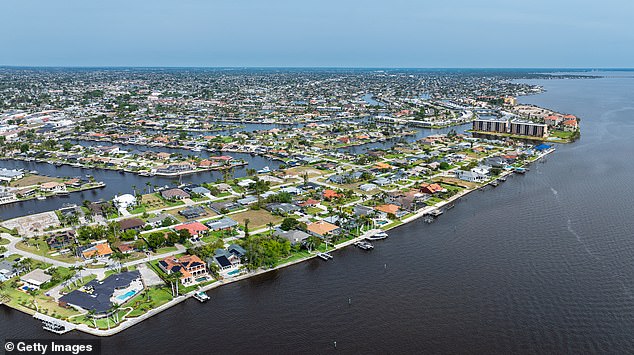Cape Coral, Florida: From Pandemic Paradise to Housing Market Crisis
Cape Coral, Florida, once hailed as a pandemic boomtown offering idyllic oceanfront remote work options, has transformed into a daunting housing market for sellers. This canal-rich city, known for its boating docks and waterfront lifestyle, now faces a crisis that has left homeowners struggling to sell.
The Rise and Fall of Cape Coral’s Housing Market
Pandemic Peak: Surge in Demand and Prices
Between 2020 and 2022, Cape Coral witnessed an influx of thousands of buyers attracted by the city’s unique lifestyle and affordable waterfront properties. During this period:
- Median home prices skyrocketed by 75%, reaching around $419,000.
- Investors flocked to the area, snapping up homes for rental income.
- The inventory was limited, creating a seller’s market.
Many believed the market was on a consistent upward trajectory, driven by remote work trends and lifestyle demands.
Current Reality: Oversupply and Buyer Hesitation
Today, Cape Coral is overwhelmed by an unprecedented housing glut:
- Lee County holds approximately 12,000 homes for sale, compared to just 3,500 two years ago.
- For sale signs cover lawns citywide, yet open houses remain eerily empty.
- Foreclosed properties abound, with some local businesses even offering foreclosure boat tours along scenic canals.
- Half-built homes sit abandoned, missing basic features like doors and windows.
Local Realtor José Echevarria describes it as “one of the worst real estate markets for a seller right now.” Over the past two years, more than 50% of listings have seen price reductions, the steepest decline in any major U.S. metro area.
Why Are Buyers Reluctant?
Skyrocketing Insurance and Taxes
A significant deterrent for buyers in Cape Coral is the cost of home ownership beyond the list price:
- Natural disaster insurance premiums have surged past $5,000 annually for most homes.
- Property taxes are steadily increasing.
- Homeowners associations (HOAs), especially in condominium complexes, are imposing hefty fees due to mandated repairs.
These costs combine to create a financial burden that scares off potential buyers, particularly investors who expected rental profits.
Impact of Natural Disasters and State Regulations
Florida’s vulnerability to hurricanes and storms has led to:
- Enhanced state regulations post the Surfside condominium collapse, dramatically increasing assessment fees required for building repairs.
-
Many older condo associations facing costly upgrades, resulting in:
- Rising insurance premiums.
- Special assessments passed onto owners.
- A decline in investment appeal.
David Podein, a real estate attorney specializing in South Florida condos, highlights a “tale of multiple markets,” where buyers prioritize newer, code-compliant properties over older buildings with pressing maintenance issues.
The Struggles of Investors and Sellers
Investment Properties Now a Liability
Many buyers who purchased during the boom to capitalize on rental income find themselves in difficult situations:
- The anticipated rental profits have evaporated as tenants and buyers shy away.
- Higher insurance costs and taxes mean many properties no longer generate positive cash flow.
- Buyers face longer market times and significant price cuts when attempting to sell.
Echevarria notes, “They’re probably hurting the most because they bought with the expectation it would make them money.”
Housing Inventory: A Double-Edged Sword
The surging inventory presents the main obstacle to market recovery:
- High supply coupled with low demand depresses prices further.
- Unless inventory slows sharply, experts warn price drops will continue.
- Increasing buyer interest depends heavily on lower interest rates and more affordable ownership costs.
Condos: A Market in Turmoil
Condominium complexes in Cape Coral and surrounding Florida areas face unique challenges:
- High HOA fees discourage potential buyers.
- Complex repair needs and state mandates after the Surfside incident have inflated operational costs.
- Many condos offer steep concessions to attract buyers.
- Inspection reports often reveal costly hidden issues.
These factors contribute to a fractured condo market struggling to regain buyer confidence.
What Needs to Happen for Recovery?
Key Factors to Stabilize the Market
- Interest rates must decline to make borrowing more affordable.
- Insurance premiums need to moderate, easing the cost burden.
- A reduction in housing inventory through increased buyer activity is critical.
- Continued legislative support for rebuilding and maintaining safe, affordable housing structures is necessary.
As Echevarria sums it up, “In order to get buyers, interest rates need to come down to get people interested in Cape Coral again.”
Conclusion
Cape Coral’s housing market turnaround depends on addressing the root causes of buyer resistance: exorbitant insurance rates, rising taxes, and a flooded market. While it remains a prime location with natural beauty and boating perks, the current financial realities overshadow its appeal. For investors and homeowners alike, navigating this crisis will require patience, strategic adjustments, and hope for more favorable economic conditions.
Related Resources
- Learn more about Florida’s real estate insurance challenges.
- Understand the impact of aftermath of the Surfside condo collapse on HOA fees and regulations.
- Explore insights on U.S. housing market trends.
By staying informed and cautious, potential buyers and sellers can better navigate the changing face of Cape Coral’s real estate landscape.


